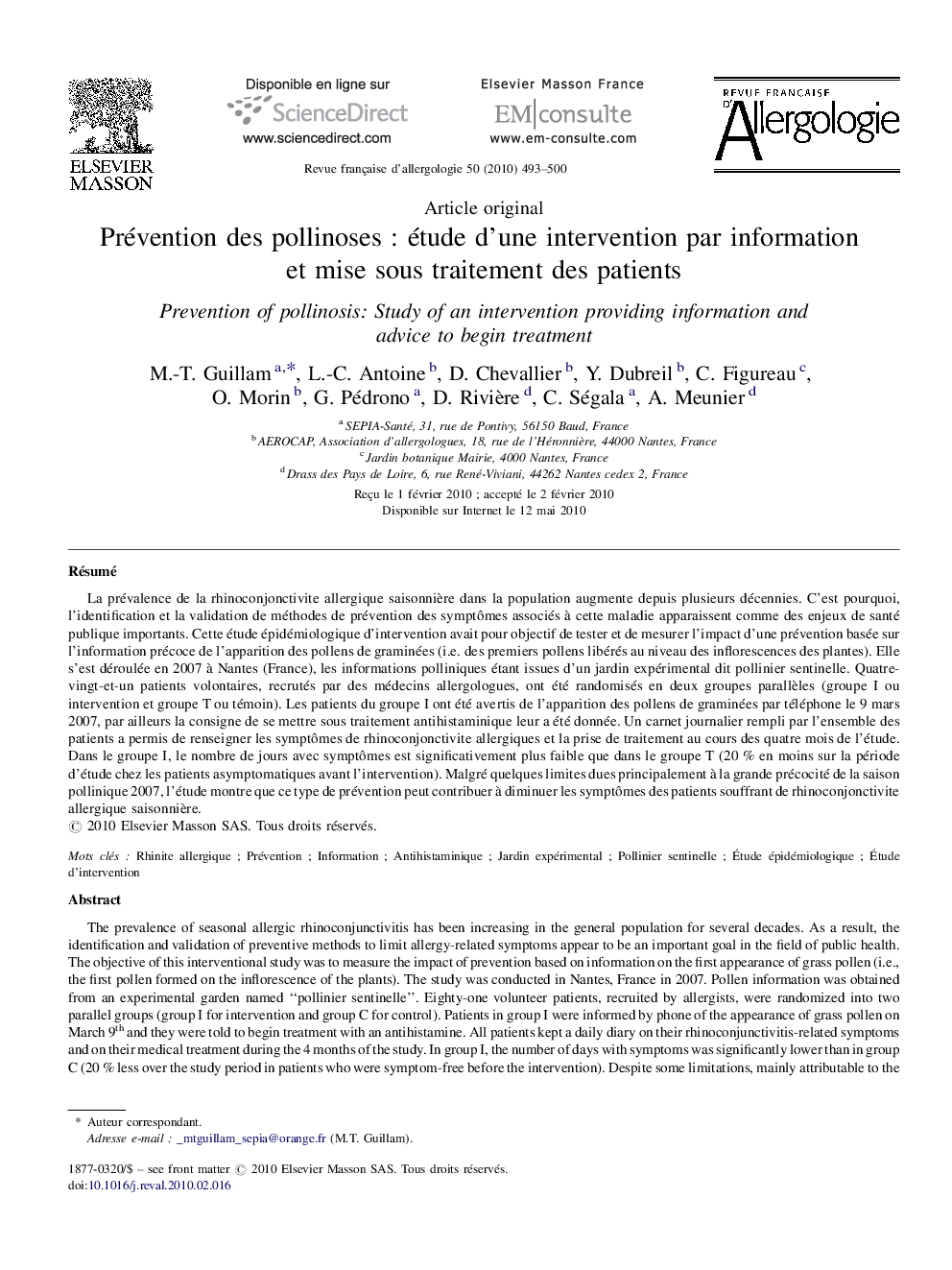| کد مقاله | کد نشریه | سال انتشار | مقاله انگلیسی | نسخه تمام متن |
|---|---|---|---|---|
| 3386917 | 1220680 | 2010 | 8 صفحه PDF | دانلود رایگان |

RésuméLa prévalence de la rhinoconjonctivite allergique saisonnière dans la population augmente depuis plusieurs décennies. C’est pourquoi, l’identification et la validation de méthodes de prévention des symptômes associés à cette maladie apparaissent comme des enjeux de santé publique importants. Cette étude épidémiologique d’intervention avait pour objectif de tester et de mesurer l’impact d’une prévention basée sur l’information précoce de l’apparition des pollens de graminées (i.e. des premiers pollens libérés au niveau des inflorescences des plantes). Elle s’est déroulée en 2007 à Nantes (France), les informations polliniques étant issues d’un jardin expérimental dit pollinier sentinelle. Quatre-vingt-et-un patients volontaires, recrutés par des médecins allergologues, ont été randomisés en deux groupes parallèles (groupe I ou intervention et groupe T ou témoin). Les patients du groupe I ont été avertis de l’apparition des pollens de graminées par téléphone le 9 mars 2007, par ailleurs la consigne de se mettre sous traitement antihistaminique leur a été donnée. Un carnet journalier rempli par l’ensemble des patients a permis de renseigner les symptômes de rhinoconjonctivite allergiques et la prise de traitement au cours des quatre mois de l’étude. Dans le groupe I, le nombre de jours avec symptômes est significativement plus faible que dans le groupe T (20 % en moins sur la période d’étude chez les patients asymptomatiques avant l’intervention). Malgré quelques limites dues principalement à la grande précocité de la saison pollinique 2007, l’étude montre que ce type de prévention peut contribuer à diminuer les symptômes des patients souffrant de rhinoconjonctivite allergique saisonnière.
The prevalence of seasonal allergic rhinoconjunctivitis has been increasing in the general population for several decades. As a result, the identification and validation of preventive methods to limit allergy-related symptoms appear to be an important goal in the field of public health. The objective of this interventional study was to measure the impact of prevention based on information on the first appearance of grass pollen (i.e., the first pollen formed on the inflorescence of the plants). The study was conducted in Nantes, France in 2007. Pollen information was obtained from an experimental garden named “pollinier sentinelle”. Eighty-one volunteer patients, recruited by allergists, were randomized into two parallel groups (group I for intervention and group C for control). Patients in group I were informed by phone of the appearance of grass pollen on March 9th and they were told to begin treatment with an antihistamine. All patients kept a daily diary on their rhinoconjunctivitis-related symptoms and on their medical treatment during the 4 months of the study. In group I, the number of days with symptoms was significantly lower than in group C (20 % less over the study period in patients who were symptom-free before the intervention). Despite some limitations, mainly attributable to the very early start of the 2007 pollen season, this study shows that this type of intervention can contribute to the reduction of symptoms in patients suffering from seasonal rhinoconjunctivitis.
Journal: Revue Française d'Allergologie - Volume 50, Issue 6, October 2010, Pages 493–500